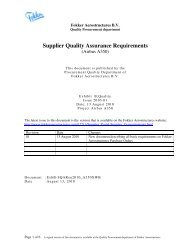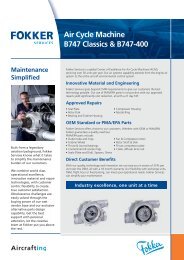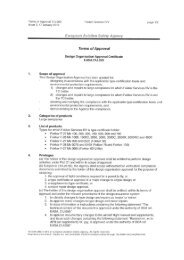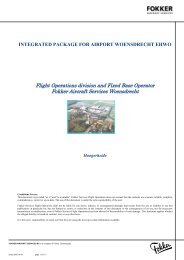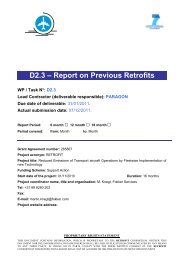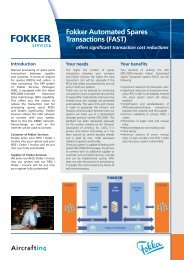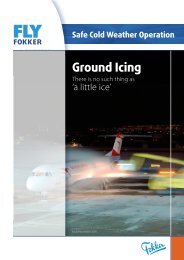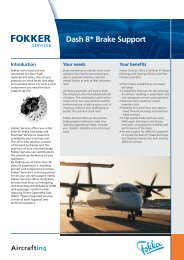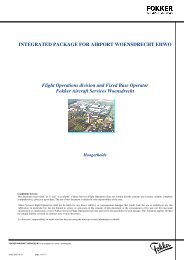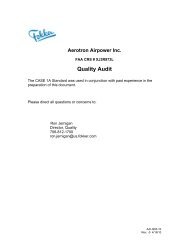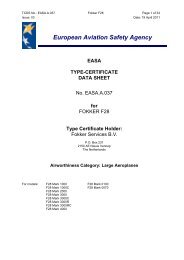D5.4 - Leaflet about Retrofit - Fokker Services
D5.4 - Leaflet about Retrofit - Fokker Services
D5.4 - Leaflet about Retrofit - Fokker Services
Create successful ePaper yourself
Turn your PDF publications into a flip-book with our unique Google optimized e-Paper software.
Several retrofitting technologies that could reduce emissions,<br />
increase passenger comfort and safety and/or improve punctuality<br />
also have a potential to be applied commercially. However, the<br />
Return On Investment (ROI) often becomes positive after a period<br />
of several years and the air transport industry seems reluctant to<br />
take this financial risk which proves to be a substantial barrier for<br />
retrofits. The EASA classification gives an indication of the certification<br />
requirements and the usage indicates how the retrofit has<br />
been applied up until now.<br />
RETROFIT<br />
Reduced Emissions of TRansport aircraft Operations by Fleetwise<br />
Implementation of new Technology<br />
Technology EASA Classification Usage RTD Required<br />
Replace whole engines with new ones; Significant Small scale No<br />
Combustor / high pressure system performance<br />
and durability upgrade; (if thrust increases by<br />
more than 10% classed as significant)<br />
Alternate fuels, not considered retrofit by consortium;<br />
(non-significant unless composition of<br />
fuel changes or thrust is increased above 10%)<br />
Non significant Large scale Yes<br />
Non significant Trial stage Yes<br />
Nacelle serrated trailing edges; Non significant Small scale Yes<br />
Active or passive suction laminar flow; Significant Trial stage Yes<br />
Winglets / Sharklets for Boeing 737, Airbus<br />
A320;<br />
Riblets in paint surface and other drag reducing<br />
coatings;<br />
Significant Large scale Yes<br />
Non significant Small scale No<br />
Zonal dryers; Non significant Large scale No<br />
Exchange of secondary structures by composite<br />
parts for weight reduction;<br />
Cabin Operation, Functioning, Safety Network<br />
and Cabin Management System (hard lined or<br />
wireless);<br />
In flight or on ground Advanced Health and<br />
Usage Monitoring Systems;<br />
Flight Data Management monitoring & improvement:<br />
Advanced flight data analysis;<br />
Upgraded Flight Management System to meet<br />
SESAR requirements;<br />
Non significant Small scale Limited<br />
Non significant Trial stage Yes<br />
Non significant Trial stage Yes<br />
Non significant Trial stage Yes<br />
Non significant Trial stage Yes<br />
Taxi with internal power; (main undercarriage) Non significant Small scale Yes<br />
Lithium batteries for secondary power; Non significant Trial stage Yes<br />
The Shear Thickening Fluid luggage Fly bag; Non significant Experimental Yes<br />
Definition of <strong>Retrofit</strong><br />
To change the design or the construction, or to include, modify or substitute<br />
parts or equipment of aircraft already in operation, in order to incorporate<br />
improvements that were not existing, available or used at the time of original<br />
manufacture.<br />
Reduce emissions now, or wait till 2030? For more information on the project<br />
‘RETROFIT’ and its results and deliverables please visit the following web<br />
address or contact the project coordinator.<br />
www.fokkerservices.com/retrofit_fp7<br />
Project Coordinator:<br />
<strong>Fokker</strong> <strong>Services</strong> B.V.:<br />
Martin Knegt, martin.knegt@fokker.com, Telephone: +31 (0)88 628 0202<br />
Acknowledgement<br />
The work described in this paper & the research leading to these results has received<br />
funding from the European Community’s Seventh Framework Programme<br />
FP7/2007-2013, under grant agreement n°265867, RETROFIT project<br />
Automatic Fire Suppression System; Non significant Large scale No<br />
Lightweight surveillance system for cockpit<br />
access, cabin or cargo surveillance;<br />
Non significant Large scale No
Context<br />
Many new technologies are developed every day. Only if a large number of<br />
new technologies can be incorporated into the new design, will a new aircraft<br />
be developed. Typically the development time of a new aircraft program is at<br />
least five years. It may take another 10 years before a sizeable fleet of the new<br />
aircraft is in operation. This implies that it will take at least 15 years before the<br />
benefits of new technologies become noticeable on a global scale.<br />
Existing aircraft still have a long life to serve, but the operational environment<br />
is changing. Airlines are confronted with emission trading, new noise legislation,<br />
increasing fuel prices and new safety and security demands. Aircraft<br />
need to operate in a new Air traffic Management (ATM) environment in which<br />
older aircraft do not comply with the new ATM standards. Also the passengers<br />
expect to be provided with high levels of comfort, communication and safety<br />
possible. Integration of new technologies on existing aircraft provides an opportunity<br />
for stakeholders and society to benefit from new technologies much<br />
earlier.<br />
The goal of the RETROFIT project is to analyze the possibilities and attractiveness<br />
of retrofitting the large fleet of commercial airliners with new technical<br />
solutions in order to satisfy todays and tomorrow’s commercial, environmental<br />
and safety demands.<br />
The RETROFIT project is a Coordination and Support Action (CSA) within the<br />
Seventh Framework Programme co-funded by the European Commission.<br />
(Grant agreement n°265867)<br />
The RETROFIT project first addressed the stakeholder requirements and<br />
investigated current and future technology options for retrofitting existing aircraft.<br />
Next, it investigated the need for research and integration activities to<br />
make retrofits attractive. It selected specific research activities that could be<br />
called for in the near-to-medium term in the RTD Framework Program of the<br />
European Commission. It also performed a cost benefit analysis on integrating<br />
selected mature (high Technology Readiness Level (TRL)) technologies<br />
on existing airline fleets. Finally, it investigated the possibilities for funding of<br />
retrofits and the possible role the European<br />
Commission could play. The results of the project will be widely disseminated.<br />
Promising cases can lead to a substantial economic activity in many<br />
European countries.<br />
The project provides recommendations to the European Commission with<br />
respect to Research and Technology Development (RTD) for retrofit to be incorporated<br />
in Framework Programme FP7 as well as for Horizon 2020. It also<br />
suggested that the Commission could create incentives for an early application<br />
of retrofits in the air transport fleet.<br />
Technology TRL Level RTD Required<br />
Cost-efficient implementation of Single European Sky ATM Research requirements<br />
(SESAR) on existing aircraft, e.g., through a validated and certifiable uniform SESAR box<br />
to be interfaced with existing avionics suites.<br />
Feasibility and implementation of advanced, stand-alone (i.e., not tied into main avionics)<br />
Health and Usage Monitoring Systems (HUMS) for structures and none-critical systems<br />
on existing aircraft, supported by RTD on air-ground communication and more advanced<br />
data communication (integrated data-power, wireless transmission) in existing aircraft.<br />
Wireless data communication in existing aircraft for integrated configurable network<br />
solutions for, e.g., advanced In-Flight Entertainment and Connectivity, cabin management<br />
and safety.<br />
3 YES Level 0/1<br />
4-6 YES Level 1<br />
4-5 YES Level 2<br />
Approach<br />
In the RETROFIT project, <strong>Fokker</strong> <strong>Services</strong> B.V., ADSE Consulting and Engineering,<br />
the National Aerospace Laboratory NLR, AD CUENTA B.V., PARA-<br />
GON S.A. and L-UP SAS worked together to analyze the possibilities and<br />
attractiveness of retrofitting the large fleet of commercial airliners with new<br />
technical solutions in order to satisfy today’s and tomorrow’s commercial,<br />
environmental and safety demands.<br />
Air-ground and at-gate communication in existing aircraft, e.g., for Advanced Health and<br />
Usage Monitoring System (AHUMS), black boxes, turn-around operations, connectivity<br />
with maintenance base and IRU fault detection.<br />
Engine systems and components retrofit development, rig testing, demonstration, and<br />
flight qualification such as combustion chamber retrofit for Nitrogen Oxide reduction.<br />
Development of a retrofit kit for nacelle and composite fan casing, for weight reduction,<br />
aerodynamics benefits (laminar flow) and potentially also reduction of noise.<br />
The long term performance of alternative, non-drop-in fuels (incl. synthetic fuel and<br />
biofuel) in existing engines without (major) modifications on existing aircraft, such as the<br />
effect on the gas path, the effect on the engine maintenance on the long term, and the<br />
effect on the engine washing.<br />
Integration and validation of new parts for the exchange of secondary structures by<br />
composite parts, for weight reduction and other structural benefits.<br />
5 YES Level 1<br />
5-6 YES Clean Sky<br />
CFC 7-8<br />
NC 1<br />
YES Clean Sky<br />
4-9 YES Clean Sky<br />
8-9 No<br />
Feasibility of a glass cockpit replacing analogue instruments in existing aircraft. 8-9 YES Per Type<br />
Alternatives to main engine based taxiing for existing aircraft, such as taxiing on internal<br />
power using electric motors in the main undercarriage, to allow main engines on idle<br />
setting or switched off during taxiing.<br />
4 YES Clean Sky



